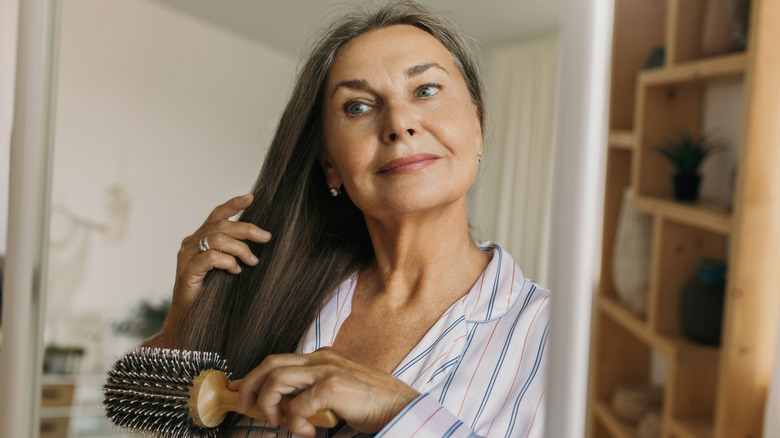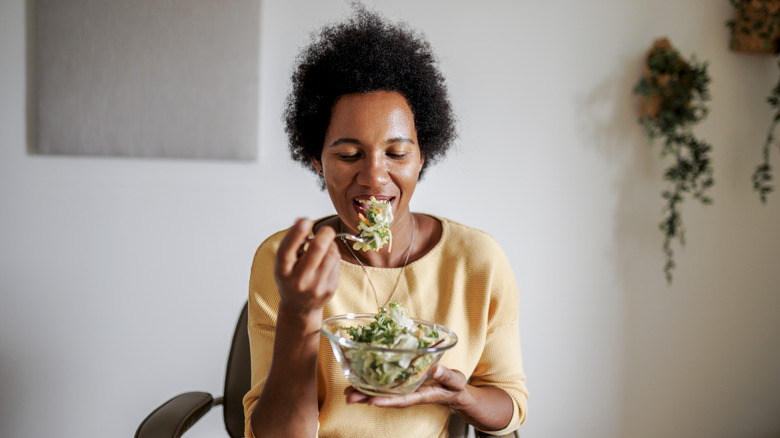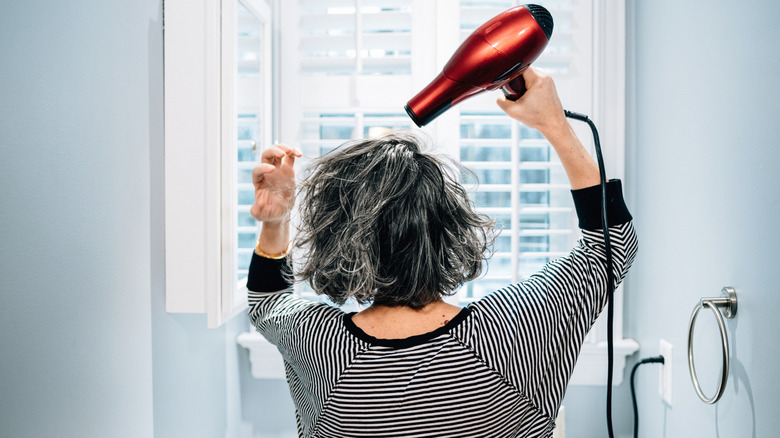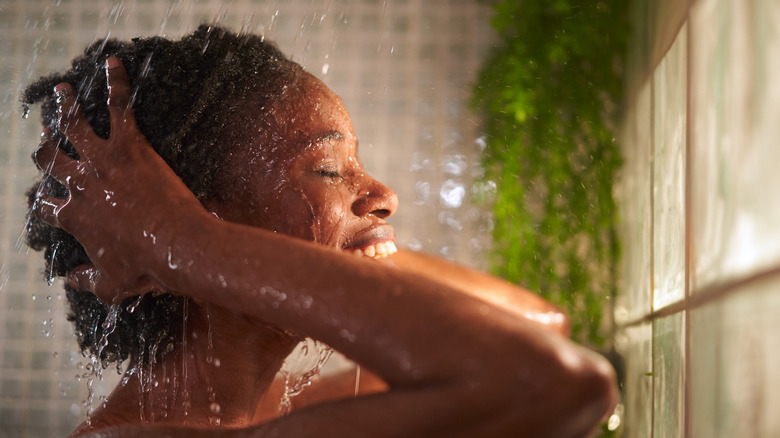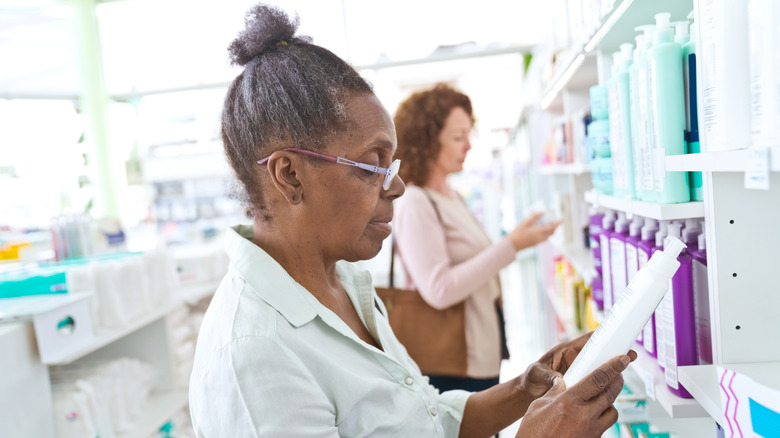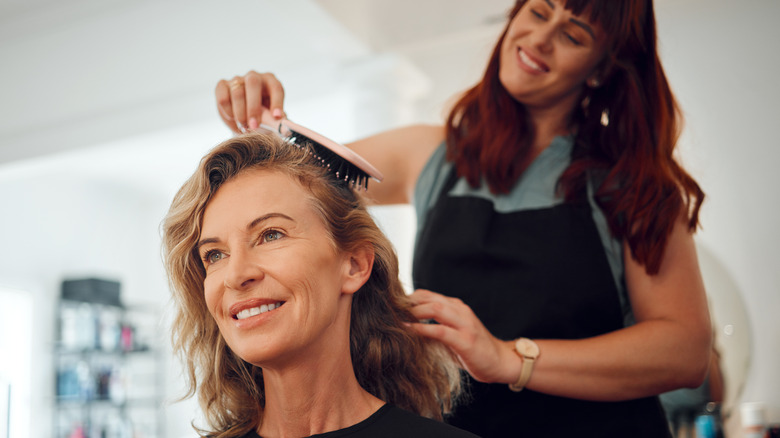5 Haircare Tips Every Woman Over 60 Needs To Know
We may receive a commission on purchases made from links.
From the wisdom you acquire to the happy memories you collect, there's so much to love about aging. One of the downsides of the process, however, is that many of our beauty and wellness routines need a little revamping as the years get away from us. When it comes to our hair, in particular, there are multiple factors to be aware of as we age. The obvious change is graying, but the quality of our strands may also be compromised, as we may experience hair loss or thinning, pattern baldness, and a slowed rate of new hair growth. You may also find that the texture of your hair changes, as volume loss is a common symptom of aging. In the face of these changes, it's important to adjust your haircare routine and make sure you're taking care of your locks to the best of your ability.
To find out what we should be doing to care for our tresses once we hit 60, Glam spoke exclusively to certified trichologist Penny James of the Penny James Trichology Center. James revealed that many of the hair problems associated with aging come down to the shrinking of the hair follicles and shorter growth cycles for the hair in general. "Our hair starts to turn gray and looks fragile, maybe breaking more easily," she adds.
The best haircare routine for women over 60 includes topical changes, such as ensuring you're using high-quality shampoo, conditioner, and other products, but James notes that it also comes down to internal care in the way of nutrition. Lastly, it's important to take care of your mental health, as stress can accelerate all parts of the aging process by damaging cell DNA and boosting inflammation. It's no wonder that stress can show in negative ways on your skin and in your strands. To this end, she recommends "staying away from toxic people" and maintaining relationships with the people who make you happy. "Have fun, dance, laugh," she advises.
Improve your diet and make nutrition a focus
Following a balanced diet is always integral to healthy hair, but this is particularly important as we age since we're also facing factors like follicle shrinkage. Penny James explains that a diet rich in healthy carbs and protein will help to ensure that your hair is growing as well as it can. "The best way to slow aging is to take good care of yourself," she observes. In our exclusive conversation, James also recommends "vitamins and minerals that are good for hair health," including "zinc, selenium, B vitamins, vitamin D and magnesium, to name a few." These can be taken in the form of supplements, or you can make changes to your diet to increase certain nutrients. To find out which nutrients or vitamins you may be lacking in, James advises checking with your doctor.
Science confirms that nutrition can improve hair health if it's lacking, but one of the things you should know before you start taking vitamins is that if a deficiency isn't the cause of your hair loss or other changes to your hair, supplements may not give you the results you're looking for. Additionally, an excess of some vitamins or minerals can actually cause damage; excessive biotin, for example, can impact blood test results. So, as James emphasizes, it's important to see your doctor before you start taking any supplements for your hair.
Pay attention to your heat-styling tools (and how you use them)
Heat-styling may leave your hair looking its best in the short term, but the long-term effects of using tools like curling irons and straighteners are less comforting. High temperatures can damage the keratin in your hair along with the cuticle, the latter of which actually serves to protect your hair from other damage. See the problem? The hair tools that cause the most damage are curling and flat irons rather than the blow-dryer, but any kind of heat-styling can leave you with fried locks if you're not careful.
Penny James believes that one of the best things you can do to ward off heat damage is replace your old tools, which may lose their temperature control and burn your hair. Tools with chips and dents can also cause damage to your hair. "I recommend new ones every five years, if not sooner," she tells Glam exclusively, also suggesting that the way you heat-style may need an upgrade. "When you blow-dry your hair, take your time, section it into organized sections, and use a boar-bristle brush." The Marilyn Brush Double S Pro Hair Brush is a good example of a rounded boar-bristle brush that's ideal for blow-drying.
Only use quality shampoo and conditioner
Using the right shampoo and conditioner is important for optimal hair health, growth, and appearance, but Penny James reveals that the "right" products are different for everyone. Rather than just using what your friends use, buying into clever marketing, or sticking with your old products because they used to suit your hair, evaluate how your locks have changed and what they need now. "If you have fine, fragile hair, I recommend Viviscal shampoo and conditioner," James shares exclusively with Glam. "It is packed with aminomar collagen complex to help keep hair strong and add shine." Similarly, if your hair is becoming drier and coarser as you age, look for shampoos and conditioners that address this concern.
At the same time, James notes that even the right shampoo and conditioner will be no match for extreme sources of damage, so it's best to steer clear of them as much as possible. "Avoid harsh chemicals and limit the times you get your hair colored, bleached, or chemically straightened," she tells us. You can recover your hair from bleach damage, but as your tresses tend to become more fragile with age, it's best to go cold turkey.
Update the rest of your hair products to meet your changing needs
Your shampoo and conditioner aren't the only products that may need to be upgraded. With some products, like treatments, heat-protectants (here are some of the best hair-protectant sprays to prevent damage), and sea-salt sprays, you may have to switch over to other brands that better address your changing needs. In other cases, it might be best to drop the product from your routine altogether, or perhaps you'll have to introduce products that you've never used before. "Your hair changes as you age, so what worked in your 30s may not work anymore," Penny James says. "You might need to add more volumizing products to make the hair look fuller. Adding hairspray to help the hairstyle stay in place. Add heat protectant before you blow-dry."
James exclusively recommends to Glam doing some investigating to figure out what products suit your hair type and investing in them, while letting go of those that no longer serve you. If you aren't sure, ask your hairstylist so you can get specific, tailored answers rather than general advice that may not suit you.
Get regular haircuts to avoid split ends
One thing that doesn't change as you age? The need for regular haircuts. We all know what happens to your hair if you stop getting regular haircuts: Say hello to split ends and a loss of shape and volume! This is even more important after 60 because you may now be dealing with thinning hair, which tends to look sparser as it gets longer. You can't repair split ends once they've formed, so if you allow your tresses to grow and split, they'll become even finer as the ends fray.
"Get your hair cut often; holding onto long, straggly hair only makes it look worse," Penny James recommends exclusively to Glam. "Keeping your hair a bit shorter makes the hair look thicker, stronger and fuller." Improved appearance is just one of the reasons you should consider short hair, not to mention the fact that it's eternally cute and trendy. If you're stuck for cropped hair inspo, check out these 25 short cuts that highlight gray hair and bring timeless elegance.
